Tour of Bavaria & city break Munich
Churches, squares and, of course, beer houses and beer gardens
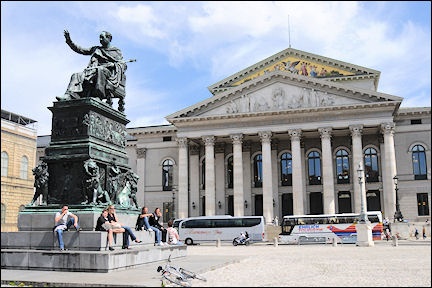
|
The tour leads via Loreley and Mittelrheintal to Hallertau, the largest hop region in the world, of course in Bavaria. Bavaria has gorgeous old towns like Kelheim on the Danube and Ansbach. Munich has a beautiful Altstadt with churches and squares. The English garden and Nymphenburg castle with Baroque garden are huge. But the beer houses, like the Hofbräuhaus which is more like a beer city, are ridiculously big.
Travelogue & photos: Mariet Arts
Early in the morning we cross the Dutch-German border. We follow the Rhine in southern direction and after Koblenz we drive through the Loreley valley. The Loreley is a 132 meters high rock along the Rhine at Sankt Goarshausen, between Koblenz and Wiesbaden.
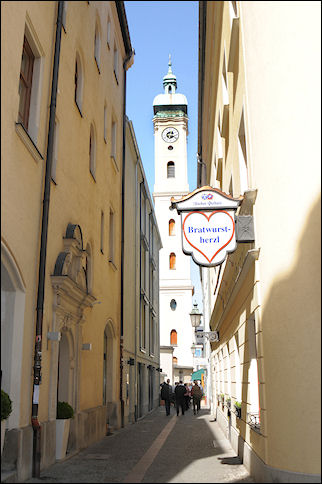
|
The Rhine meanders around Loreley with a sharp turn. This is the narrowest point of the river (113 meters) and also its deepest (25 meters). This causes dangerous currents. In the past, many ships were wrecked. Even though the most dangerous parts are dealt with, ships are still warned about this dangerous passage.
There is a lookout point on the Loreley rock which has a great view of the bend in the Rhine, Sankt Goarshausen and Katz Fortress. According to one of the legends about Loreley, a singing nymph (whose name was also Loreley) with golden hair sat on the rock, distracting skippers with her song, causing them to wreck their ships on the rocks. This story is very similar to that of the Greek Sirenes. At the foot of the Loreley stands a statue of the nymph.
Mittelrheintal at Rüdesheim
Wine houses, bars, outdoor cafés, kitsch and knick knacks
We arrive in the German state of Hessen, which is mainly known for its wine growing and wine trade. The landscape at Rüdesheim, the Mittelrheintal, is protected Unesco World Heritage, among other reasons for its over forty medieval fortresses on mountains along the Rhine.
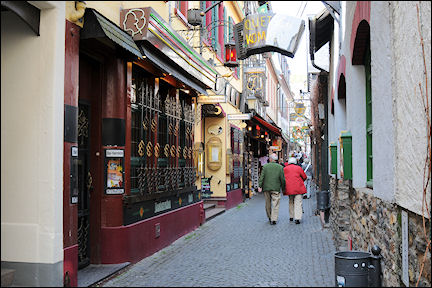
|
After a short coffee break it's now time to stretch our legs. In Rüdesheim town center we stroll through the best known street of this town: Drosselgasse, a 144 meters long, somewhat ascending alley, packed with souvenir shops, wine houses, bars, outdoor cafés, kitsch and knick knacks.
Siegfried's Mechanisches Musikkabinett is a museum with 350 automated musical instruments, from small musical clocks to large and heavy barrel organs. It is located in Brömserhof, a beautiful timbered castle in the Oberstrasse in Rüdesheim.
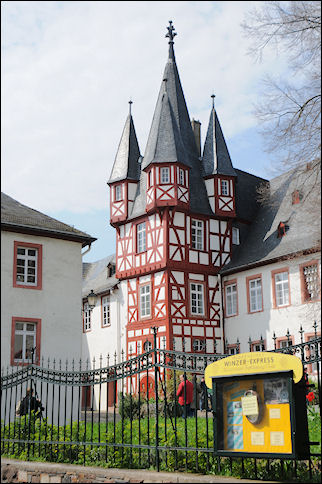
|
It's possible to visit the Niederwald Denkmal on a hill near Rüdesheim on foot along vineyards or by cable lift. The memorial is the symbol of the reconstruction of the German empire after the German-French war (1870-1871). Germania stands with the imperial crown in her raised right hand and the imperial sword in her left. In the distance we see the ruins of the fortress Ehrenfels.
We only stay for a short while in the very touristy center of Rüdesheim and bring a short visit to the nearby Hugo Asbach distillery which dates from 1892. Asbach Uralt is a wine distillate with an alcohol percentage of 38. It is made of imported French white grapes and is sometimes compared to French cognac.
An informative Multivisions Show shows the complete process from grape to booze; of course we want to taste some afterwards.
Hopfenland Hallertau
Green, rolling fields of hop with seven-meters-high poles
We drive southward in an atmospheric, varied landscape along mountains with vineyards, castles, Baroque churches, cities and villages.
It's already late when we are welcomed with a cordial "Gruüss Gott" by the hostess of a Gasthof in Reichertshofen, a town on the edge of Hopfenland Hallertau, the largest hop region in the world, in the heart of Bavaria. We are very tired and retreat to our room immediately after dinner.
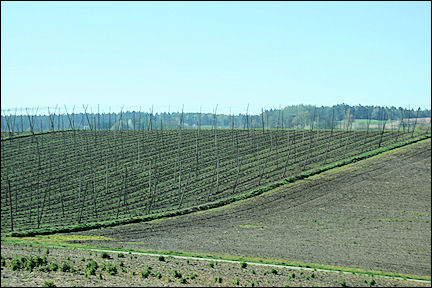
|
It rains cats and dogs the next day when we drive along lots of green, rolling fields of hop with seven-meters-high poles. Hop is a herbal creeper which winds itself around the wires that connect the poles.
The "bells" that grow on the hop plant are its most important parts; they are harvested in August. The bitter substance which is produced by the bells is a raw material for the production of beer. Bavarians proudly call hop "das Grüne Gold" (Green Gold).
Kelheim on the Danube
Medieval towers and gates
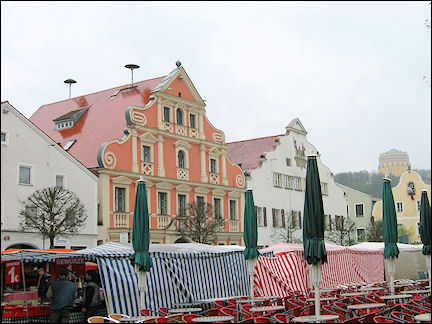
|
We visit the Tropfsteinhöhle (stalactite cave) Schulerloch in Essing in the Altmuhltal (Altmuhl Valley). Their entrance is at a height of 50 meters. In pre-historical times they housed Neanderthals. The air in the caves is very humid and there is a constant temperature of 9 degrees centigrade.
Unfortunately we're not allowed to take pictures in the cave. Back outside the temperature is somewhat higher but it still rains.
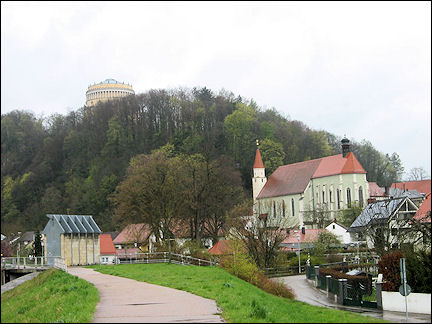
|
A little later we arrive in Kelheim on the Danube. When we drive into the town, we see the monumental building of the Befreiungshalle (Liberation Hall), the city's best know landmark. It is built on the Michelsberg (Michael's Mountain).
In memory of the war of liberation against Napoleon King Ludwig I of Bavaria commissioned the famous Munich architect Leo von Klenze to build the monumental round building, which was constructed between 1842 and 1863.
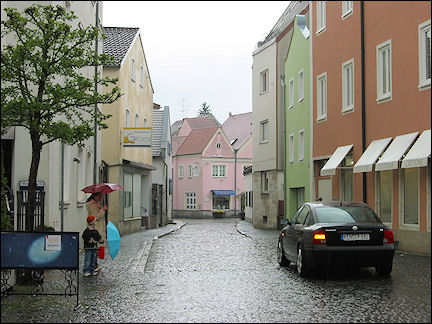
|
The entrance door of the Befreiungshalle and the shields of the victory goddesses are made of bronze from seized French cannons. The floor is decorated with marble mosaics.
Nearby is a Franziskaner-Klosterkirche (Franciscan Monastery Church), dating from 1460, which nowadays houses an organ museum. The most important part of the collection consists of three types of organs which sit on the upper floor of the cloister. All instruments are in tune with one another, to enable concerts in which several organs are played together.
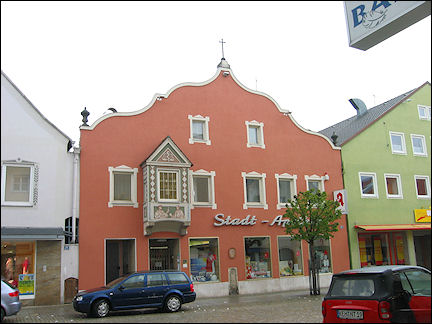
|
Kelheim has a beautifully preserved old city center with medieval towers and gates. It's a pity about the weather but despite the rain we wander through the empty city.
One of the façades has a tombstone, dating from 1249, with Hebrew inscriptions, probably looted from a Jewish cemetary. The tombstone was built into the front of the City Pharmacy in 1519. Originally there also was an anti-semitic picture, which was removed after WWII.
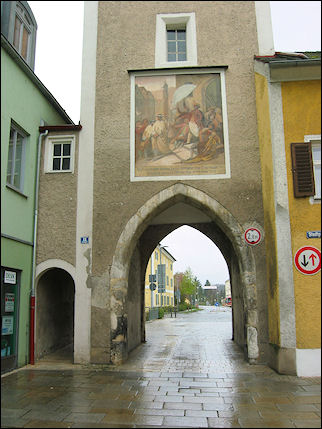
|
The stalls in the marketplace look abandoned and desolate, the outdoor cafés and streets are wet and empty. But we still enjoy the beautiful houses with their colorful façades from under our umbrellas.
Not far from the church at Ledergasse 11 is the archeological museum, housed in a late-Gothic Herzogkasten, a grain silo on the edge of town. Unfortunately we don't have enough time to visit it.
We walk via one of the medieval city gates to the landing of the Maxmilian II for a tour of the schöne blaue Donau (beautiful blue Danube).
Weltenburg
Benedictine abbey below eighty-meters-high rock wall
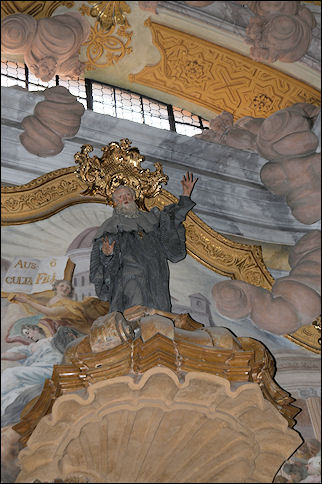
|
The 47-meters-long ship Maxmilian II takes us through the beautiful nature reserve Weltenburger Enge. At Weltenburg Monastery, a Benedictine monastery, we get off the ship. The monastery sits on a peninsula, immediately below the eighty-meters-high rock wall of the Donaudurchbruch.
The first abbey was built by Irish-Scottish monks in 620. During an important renovation in the eighteenth century the Baroque church next to it received its current shape.
Inside, I'm amazed at the profusion of sumptuous Baroque decorations. They are the work of the famous Baroque artist Cosmas Damian Asam, together with his six years younger brother Egid Quirin Asam. Their fresco on the ceiling, of celestial Jerusalem, knocks me off my feet.
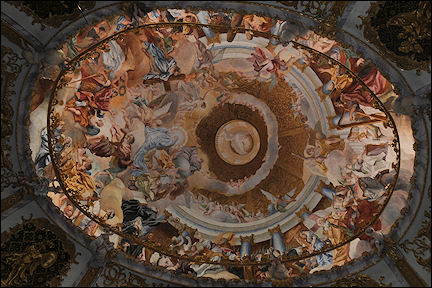
|
The many seperate works of art in the church are somehow connected and form a harmonic unity.
In the adjoining pilgrimage chapel is the statue "Unserer Lieben Frau von Weltenburg".
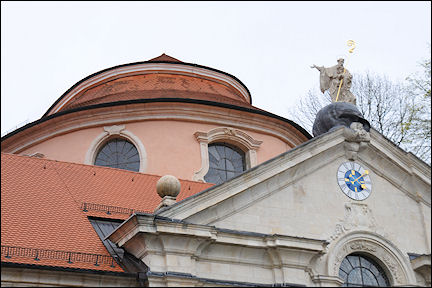
|
The monastery brewery Weltenburg is the oldest of its kind in the world. Since 1050 the Benedictine monks brew beer here according to their own tradition.
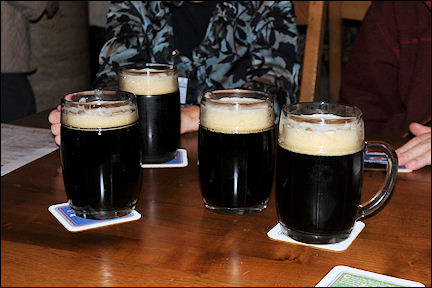
|
In the visitors center of the abbey we see a movie about the processing of hop, ending with the prize-winning beer. A little later we discover ourselves what a mug of dark monastery beer tastes like; in 2004 it won the World Beer Award for the best dark beer in the world.
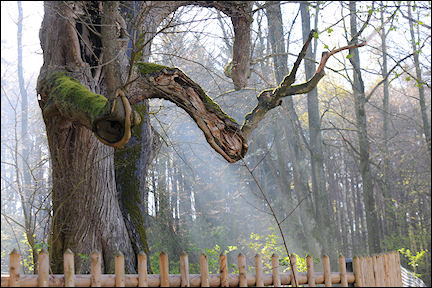
|
The next morning we get up as soon as the first ray of sunlight makes its way between our curtains. After breakfast we take a nearby path into the forest and pass the Sankt-Kastl-Linde or Kastulus linden, a centuries-old linden tree, about 25 meters tall.
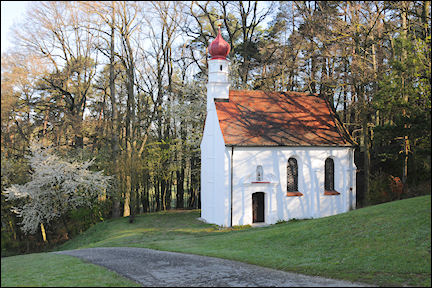
|
I read that the linden flowers from grandmother's pharmacy are used to make "home tea" and that the linden is considered a friend and bringer of good luck for mankind. The large hole in the trunk of the old linden looks like an open mouth with a long arm on each side.
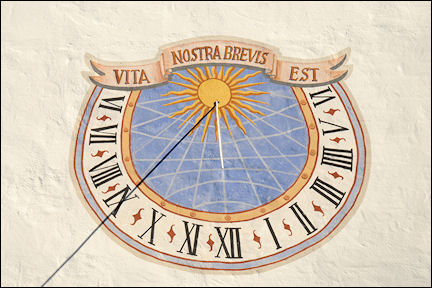
|
A little farther sits a Bavarian pilgrimage church with a chapel dedicated to St. Kastules, patron saint of Hallertau. Here we have a great view of the valley with fields full of hop poles. A painted sundial on the church tells us the exact time, thanks to the appearance of the sun.
Schloss Nymphenburg Munich
Summer residence of five generations of Wittelsbachers
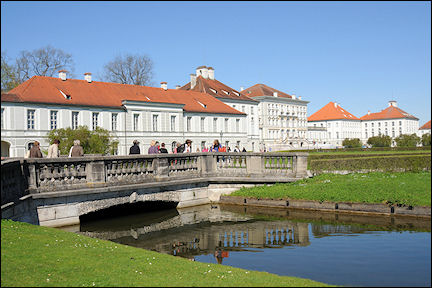
|
Back at the hotel, we leave again immediately for Munich (Minga in Bavarian dialect) Bavaria's capital. Just before we reach Munich, we see the snow-capped Bavarian Alps in the distance.
First we visit Schloss Nymphenburg in the western part of Munich.
The huge castle was built in the seventeenth century and renovated in the nineteenth century. For two centuries it was the summer residence of five generations of Wittelsbachers. Wittelsbach is the royal house that provided Bavaria's earls, dukes and kings, between 1180 and 1918.
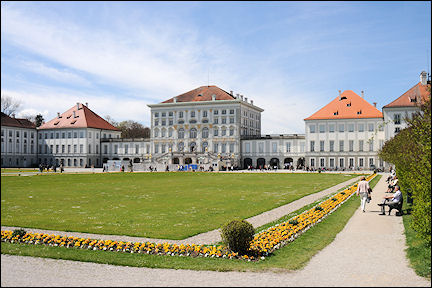
|
Nymphenburg Castle has a wonderful park, modelled after the garden in Versailles. The well maintained Baroque garden with marble statues of gods, the botanical garden, the ponds and canals in which swans and ducks swim, make a walk here a pleasant experience.
Scattered over the park are several buildings, among which Amalienburg, a Rococo jewel. Karl Albert of Bavaria had it built for his wife Maria Amalia of Austria.
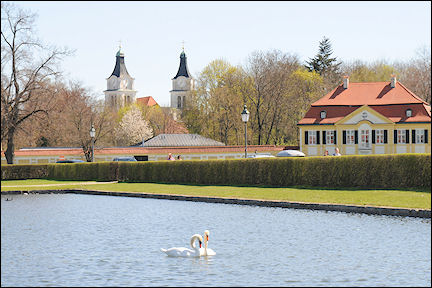
|
The Marstall Museum, housed in the southernmost building, has a collection of showy carriages and sleds. There are regular concerts in the Hubertus Hall throughout the year.
We are getting tired of walking, but fortunately we find a place in the biergärten (beer garden) to rest for a while. Our table doesn't have a tablecloth. Waiters run back and forth, but we are ignored, so we serve ourselves. Later we hear that there is an old tradition in Munich biergärtens that there is no service for tables without a cloth, but on the other hand you are allowed to eat food there you brought with you.
Altstadt Munich
Churches, squares and a city-hall tower with carillon
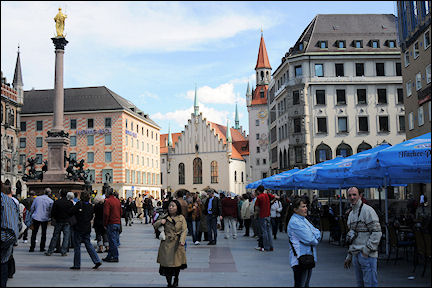
|
Via the Olympic Park, where the Olympics were held in 1972, the entertainment and artists district Schwabing and a huge English garden we eventually arrive in the city center.
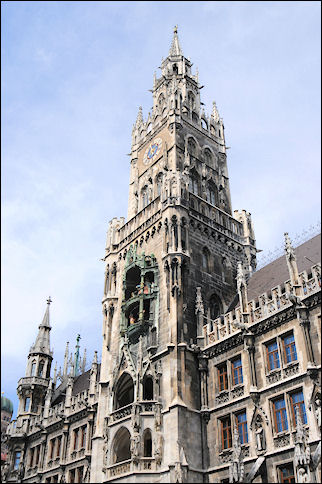
|
At the heart of Munich's Altstadt lies Marienplatz. At the center of the square stands the Mariensäule, an over 11 meters tall column with a Maria statue by the Dutch sculptor Hubert Gerhart. On the railing Baroque puttoes fight dragons, lions, basilisks and snakes.
On the east side of Marienplatz sits the old City Hall, which houses a toy museum. Nearby is the new, nineteenth century Gothic revival city hall. Its over eighty meters tall tower has 43 bells. On its spire stands the famous Münchner Kindl, which is Bavarian for Munich's child. It is Munich's coat of arms and we'll see it all over the place.
The most interesting sight is the Glockenspiel (carillon). Moving figurines dance several times a day, on fixed times, to the music of the carillon. Their dance portrays two events from the city's history.
It's fun to watch how crowds of people look up when the carillon begins to play and everything starts to move.
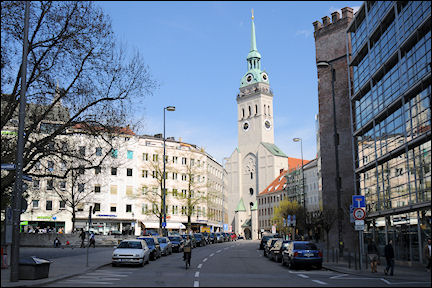
|
South of Marienplatz we visit the St. Peterskirche (St. Peter Church), with a tower named Alter Peter (Old Peter) from which you have a great view of the Bavarian Alps on a clear day.
We walk to the Max-Joseph Platz, named after the first king of Bavaria, whose statue sits in the middle of the square. Behind it we see the Residenzmuseum and the Classicist Nationaltheater, home of the Bavarian State Opera.
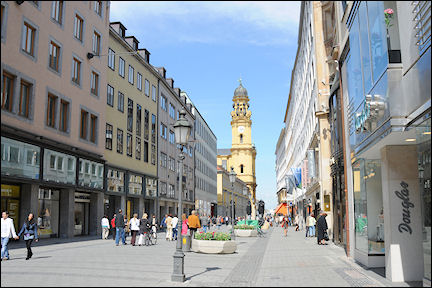
|
Via the Perusastrasse we arrive in the Theatinerstrasse, a wide, posh shopping street with the yellow Theatiner Church at one end. We cross a shopping mall and arrive on the Frauenplatz with the late-Gothic Dom zu Unsere Lieben Frau, the Our-Lady Church.
This church is over 100 meters long and over 40 meters wide; it has a huge saddle roof. Its two tall towers with spheric domes can be seen from a long distance. It is the largest building in Munich and one the largest churches in southern Germany
Hofbräuhaus
This beer house looks like a beer city with its many halls
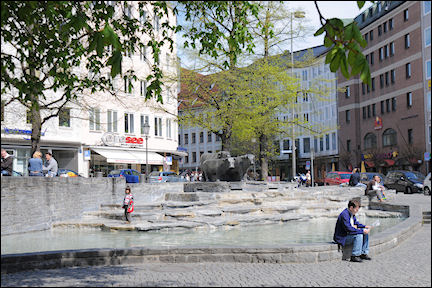
|
After visiting the Our-Lady Church we resume our tour of Munich. Via Kaufingerstrasse, Rosenstrasse, Rindermarkt and Rosental we arrive at Sankt-Jakobs-Platz. It's as if the sun shines twice as bright on this square surrounded by white buildings.
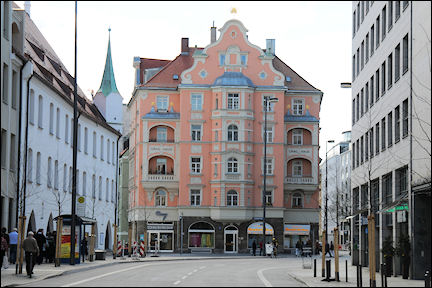
|
On one side of the square stands the late-medieval Oraghaus of the famous Rococo sculptor Ignaz Günther. At the center of the square, as a free-standing cube, the new Jewish Center, which has a museum, a community building and a synagogue. Part of its permanent exhibition is an overview of Jewish history and culture in Munich.
The film museum and city museum are both bright white buildings with red roofs. The film museum has a film theatre in which rarely shown movies are shown daily. The city museum houses different museums.
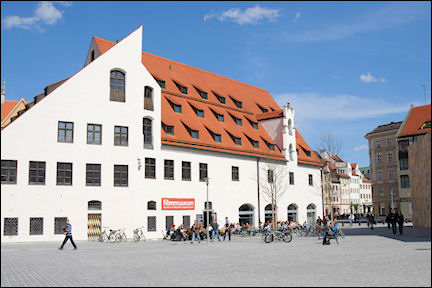
|
We are close to the Sendlingerstrasse where the home and private church of Baroque artist Egid Quirin Asam are.
A true afficionada can't leave Munich without having visited the world's most famous Wirtshaus (inn), Hofbräuhaus. At least, that is what a poster on a wall tells us and, curious as we are, we set out to find it.
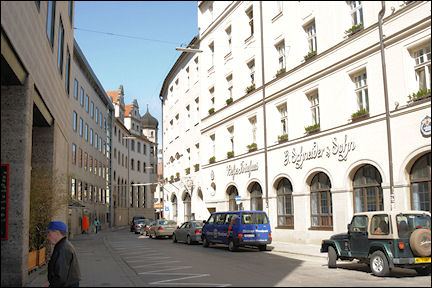
|
We pass the famous Viktualien market, where every day, except for Sundays, you can buy vegetables, fruit, meat, fish, wine, nuts, sausages in all shapes and sizes and other delicacies.
In one of the streets we pass an original Bratwürstherzl. It is one of the few remaining traditional Bratwurst restaurants that serve grilled Nürnbergse Bratwürste or other tasty bratwurst snacks.
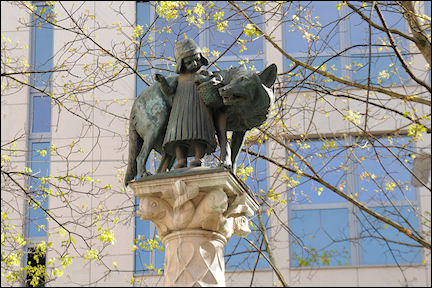
|
We cross the busy street Im Tal, pass the huge front of the Weisses Bräuhaus Schneider and arrive at the gorgeous Bavarian square Am Platz.
High on a column, between the green tree leaves, stands Little Red Riding Hood with the wolf from one of the many Grimm fairy tales. The German brothers Jacob and Wilhelm Grimm collected German sagas and fairy tales as told by the people, retold them in simple and popular ways and published them as Kinder- und Hausmärchen (Fairy Tales for Children and Home).
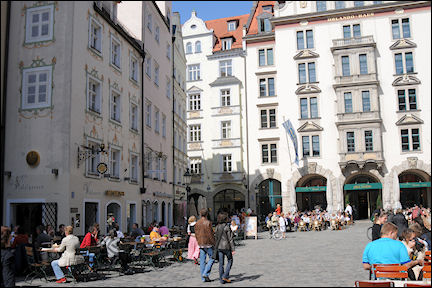
|
The Orlandohaus, which houses a restaurant, is an eye-catcher. Around the windows of a Platzlgassen paintings were made according to a Bavarian tradition.
Hofbräuhaus with its many halls and biergärtens is actually more like a beer city. Almost 7,000 people can quench their thirst here. The brochure tells me that it is not an exception that in one day 20,000 liters of beer are tapped.
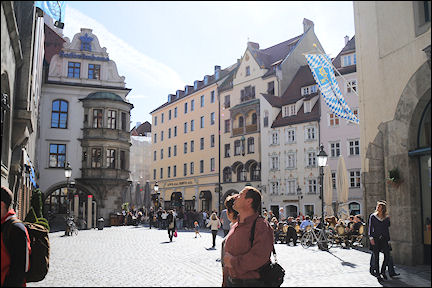
|
The name Hofbräuhaus is a reminder that originally this brewery only produced beer for the royal court. Its popularity probably comes from its real Bavarian-style coziness.
An orchestra in which the men wear lederhosen plays in the bar. People in authentic Bavarian traditional garb sit at the Stammtisches, which can also be rented, and drink large quantities of beer. It's as if I find myself in an old-fashioned fairy tale: colours and cheerfulness, a cozy and funny company.
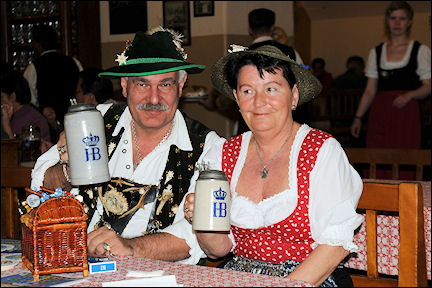
|
I can't withstand the temptation to ask people if I can take pictures of them. "Natürlich, das können Sie gern tun," they answer. But I have to wait, because first they want to place the tin cap with the Münchner Kindl on the earthenware mug from which they drink their beer.
There is room to sit in the Hofbräuhaus biergärten. We can choose from many kinds and quantities of beer. As a snack we have Weisswurst, which was recommanded.
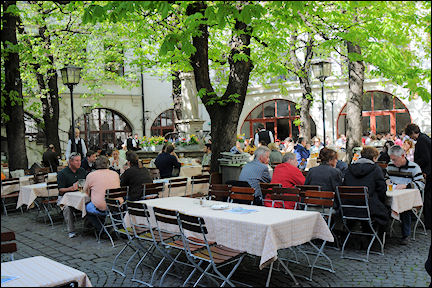
|
Weisswurst is white type of sausage from Munich, made of calf sausage (with or without pork added), onions, parsley, mace and lemon. According to Bavarian tradition it is served with sweet mustard and brezen, a kind of bread pretzel.
Thus ends our tour of Munich. Munich is a living museum, with beautiful squares and streets, old gates, gorgeous churches and wonderful beer gardens. A city of art and culture where we'll certainly return in the future.
Ansbach
Former royal residence, surrounded by hills and woods
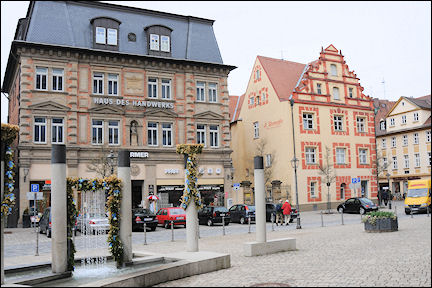
|
The next morning we leave early for The Netherlands. The last town we visit in Bavaria is Ansbach, near Neurenberg. When we pass the Schlossthor (castle gate) we find ourselves in the town center.
In one of the squares is a stall that sells brezen, the bread pretzels we just had in Munich.
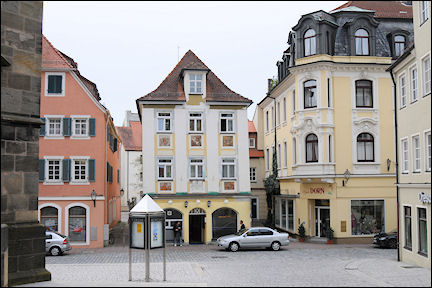
|
In the same square as the St. Johannis church stands the birth house of the poet Friedrich Wilhelm Güll, mainly known for his songs and poems for children. The front of the house is decorated with all kinds of children scenes.
Near the church is a fountain dedicated to the memory of the poet. One of his best-known poems is "Der Pflaumenregen " (The Plum Rain).
We leave Bavaria behind us and after a few short breaks we arrive at the Dutch border; our German trip is over.